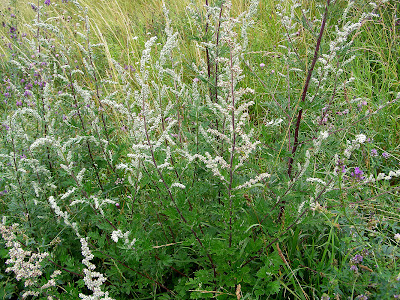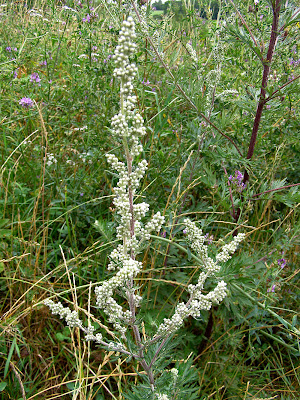On our short walk this morning, there was one plant in particular which caught my attention. Growing among the many members of the pea family which have made the old car-parks of the local Theme Park site, their home, was an impressive plant. Growing up to 5ft tall and grey-green in colour, with red, grooved stems and topped with hundreds of cottony, white flowers, the plant is called Mugwort (Artemisia vulgaris).
Also known as Common Wormwood, it has been used by humans for thousands of years in various medicinal compounds and even has links to witchcraft. Mugwort - like it's close relative Wormwood (Artemisia absinthium) - contains a chemical compound called thujone. This chemical is found in the infamous drink, Absinthe and may be responsible for that beverage's reported psychedelic effects. Recent research has shown that one would have to imbibe a huge amount of Absinthe in order to cause the reported mind-altering effects. In fact, your liver would 'alter' long before your mind!
Thujone is the substance which has been responsible for the plant's use in spells and witchcraft. Inducing hallucinogenic visions, it has been used as a smoking-herb and as an addition to pillows, inducing vivid dreams in the patient (victim?).
The flowers have also been used as a flavouring/seasoning for meats and fish. Picked before the flowers open, the young leaves have been used in the same way. The plant has been used as an anthelmintic drug for the removal of intestinal and parasitic worms.
Who would have thought so many uses would have been found for such a commonplace 'weed'.
As a footnote, in Ukranian, the plant is called Chornobylnik. The name of the abandoned city of Chernobyl means "place where Mugwort grows".



No comments:
Post a Comment